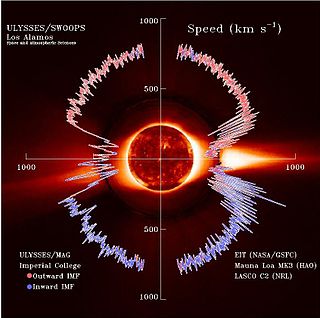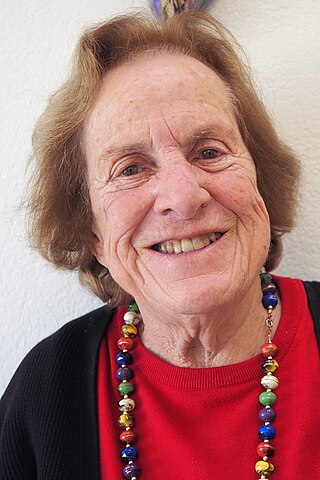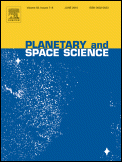Related Research Articles

In astronomy and planetary science, a magnetosphere is a region of space surrounding an astronomical object in which charged particles are affected by that object's magnetic field. It is created by a celestial body with an active interior dynamo.

The solar wind is a stream of charged particles released from the Sun's outermost atmospheric layer, the corona. This plasma mostly consists of electrons, protons and alpha particles with kinetic energy between 0.5 and 10 keV. The composition of the solar wind plasma also includes a mixture of particle species found in the solar plasma: trace amounts of heavy ions and atomic nuclei of elements such as carbon, nitrogen, oxygen, neon, magnesium, silicon, sulfur, and iron. There are also rarer traces of some other nuclei and isotopes such as phosphorus, titanium, chromium, and nickel's isotopes 58Ni, 60Ni, and 62Ni. Superimposed with the solar-wind plasma is the interplanetary magnetic field. The solar wind varies in density, temperature and speed over time and over solar latitude and longitude. Its particles can escape the Sun's gravity because of their high energy resulting from the high temperature of the corona, which in turn is a result of the coronal magnetic field. The boundary separating the corona from the solar wind is called the Alfvén surface.

An aurora , also commonly known as the northern lights or southern lights, is a natural light display in Earth's sky, predominantly seen in high-latitude regions. Auroras display dynamic patterns of brilliant lights that appear as curtains, rays, spirals, or dynamic flickers covering the entire sky.

The magnetosheath is the region of space between the magnetopause and the bow shock of a planet's magnetosphere. The regularly organized magnetic field generated by the planet becomes weak and irregular in the magnetosheath due to interaction with the incoming solar wind, and is incapable of fully deflecting the highly charged particles. The density of the particles in this region is considerably lower than what is found beyond the bow shock, but greater than within the magnetopause, and can be considered a transitory state.

Cluster II was a space mission of the European Space Agency, with NASA participation, to study the Earth's magnetosphere over the course of nearly two solar cycles. The mission was composed of four identical spacecraft flying in a tetrahedral formation. As a replacement for the original Cluster spacecraft which were lost in a launch failure in 1996, the four Cluster II spacecraft were successfully launched in pairs in July and August 2000 onboard two Soyuz-Fregat rockets from Baikonur, Kazakhstan. In February 2011, Cluster II celebrated 10 years of successful scientific operations in space. In February 2021, Cluster II celebrated 20 years of successful scientific operations in space. As of March 2023, its mission was extended until September 2024. The China National Space Administration/ESA Double Star mission operated alongside Cluster II from 2004 to 2007.
Space physics, also known as space plasma physics, is the study of naturally occurring plasmas within Earth's upper atmosphere and the rest of the Solar System. It includes the topics of aeronomy, aurorae, planetary ionospheres and magnetospheres, radiation belts, and space weather. It also encompasses the discipline of heliophysics, which studies the solar physics of the Sun, its solar wind, the coronal heating problem, solar energetic particles, and the heliosphere.

Heliophysics is the physics of the Sun and its connection with the Solar System. NASA defines heliophysics as "(1) the comprehensive new term for the science of the Sun - Solar System Connection, (2) the exploration, discovery, and understanding of Earth's space environment, and (3) the system science that unites all of the linked phenomena in the region of the cosmos influenced by a star like our Sun."

Joan Feynman was an American astrophysicist and space physicist. She made contributions to the study of solar wind particles and fields, sun-Earth relations, and magnetospheric physics. In particular, Feynman was known for developing an understanding of the origin of auroras. She was also known for creating a model that predicts the number of high-energy particles likely to hit a spacecraft over its lifetime, and for uncovering a method for predicting sunspot cycles.
The Royal Belgian Institute for Space Aeronomy (BIRA-IASB) is a Belgian federal scientific research institute. Created in 1964, its main tasks are research and public service in space aeronomy, which is the physics and chemistry of the atmosphere of the Earth and other planets, and of outer space. The scientists rely on ground-based, balloon-, air- or space-borne instruments and computer models.

Planetary and Space Science (P&SS), published 15 times per year, is a peer-reviewed scientific journal established in 1959. It publishes original research articles along with short communications (letters). The main topic is Solar System processes which encompasses multiple areas of the natural sciences. Numerical simulations of solar system processes are also conducted at ground-based facilities or on-board space platforms. The editor-in-chief is Maria Cristina De Sanctis. It is published by Elsevier.
The Institute of Atmospheric Physics AS CR (Czech: Ústav fyziky atmosféry Akademie věd České republiky), also designated as the IAP, is part of the Academy of Sciences of the Czech Republic (AS CR). Within the IAP research institutions are combined in order to cover the whole field of science and humanities.
The Arctowski Medal is awarded by the U.S. National Academy of Sciences "for studies in solar physics and solar-terrestrial relationships." Named in honor of Henryk Arctowski, it was first awarded in 1969.

The Heliophysics Science Division of the Goddard Space Flight Center (NASA) conducts research on the Sun, its extended Solar System environment, and interactions of Earth, other planets, small bodies, and interstellar gas with the heliosphere. Division research also encompasses geospace—Earth's uppermost atmosphere, the ionosphere, and the magnetosphere—and the changing environmental conditions throughout the coupled heliosphere.

Margaret Galland Kivelson is an American space physicist, planetary scientist, and distinguished professor emerita of space physics at the University of California, Los Angeles. From 2010 to the present, concurrent with her appointment at UCLA, Kivelson has been a research scientist and scholar at the University of Michigan. Her primary research interests include the magnetospheres of Earth, Jupiter, and Saturn.

Solar wind Magnetosphere Ionosphere Link Explorer (SMILE) is a planned joint venture mission between the European Space Agency and the Chinese Academy of Sciences. SMILE will image for the first time the magnetosphere of the Sun in soft X-rays and UV during up to 40 hours per orbit, improving our understanding of the dynamic interaction between the solar wind and Earth's magnetosphere. The prime science questions of the SMILE mission are

Space climate is the long-term variation in solar activity within the heliosphere, including the solar wind, the Interplanetary magnetic field (IMF), and their effects in the near-Earth environment, including the magnetosphere of Earth and the ionosphere, the upper and lower atmosphere, climate, and other related systems. The scientific study of space climate is an interdisciplinary field of space physics, solar physics, heliophysics, and geophysics. It is thus conceptually related to terrestrial climatology, and its effects on the atmosphere of Earth are considered in climate science.
Tuija I. Pulkkinen is a Finnish space physicist. Her primary research foci are studying the energy flow from the solar wind to the near-Earth space environment and the energy dissipation processes in the magnetosphere.

Mei-Ching Hannah Fok is a research space physicist at the Goddard Space Flight Center. She was awarded the NASA Exceptional Scientific Achievement Medal in 2011 and elected a Fellow of the American Geophysical Union in 2019. She has worked on the IMAGE, Van Allen Probes and TWINS missions.
Mary Hudson is the Eleanor and Kelvin Smith Distinguished Professor of Physics at Dartmouth College. She is known for her research on the weather patterns that occur due to solar eruptions. She was elected a fellow of the American Geophysical Union in 1984.
Caitríona M. Jackman is an Irish space physicist. In 2021, she became the first female senior professor at the Dublin Institute for Advanced Studies (DIAS) Dunsink Observatory. She has made important contributions to understanding the solar wind interactions with planetary magnetospheres.
References
- ↑ "List of Members" (PDF). Finnish Society of Sciences and Letters . 2020s. Retrieved 13 March 2024.
- ↑ "Minna Palmroth". University of Helsinki. Retrieved 26 July 2018.
- ↑ "Six-dimensional model for space weather forecasts | University of Helsinki". University of Helsinki. 25 April 2017. Retrieved 26 July 2018.
- ↑ Pokhotelov, D.; von Alfthan, S.; Kempf, Y.; Vainio, R.; Koskinen, H.E.J.; Palmroth, M. (17 December 2013). "Ion distributions upstream and downstream of the Earth's bow shock: first results from Vlasiator". Annales Geophysicae. 31 (12): 2207–2212. Bibcode:2013AnGeo..31.2207P. doi: 10.5194/angeo-31-2207-2013 . hdl: 10138/161497 .
- 1 2 "Minna Palmroth | Diversity in HPC". www.hpc-diversity.ac.uk. Retrieved 26 July 2018.
- ↑ "DSpace". helda.helsinki.fi. Retrieved 15 October 2024.
- ↑ PhD, Minna PalmrothUniversity of Helsinki | HY · Department of Physics 34 85 ·. "Minna Palmroth | PhD | University of Helsinki, Helsinki | HY | Department of Physics". ResearchGate. Retrieved 26 July 2018.
{{cite web}}: CS1 maint: numeric names: authors list (link) - ↑ "Tekniikan Maailma". tekniikanmaailma.fi. Retrieved 15 October 2024.
- ↑ "Minna Palmroth". Member. Academia Europaea. Retrieved 4 October 2024.